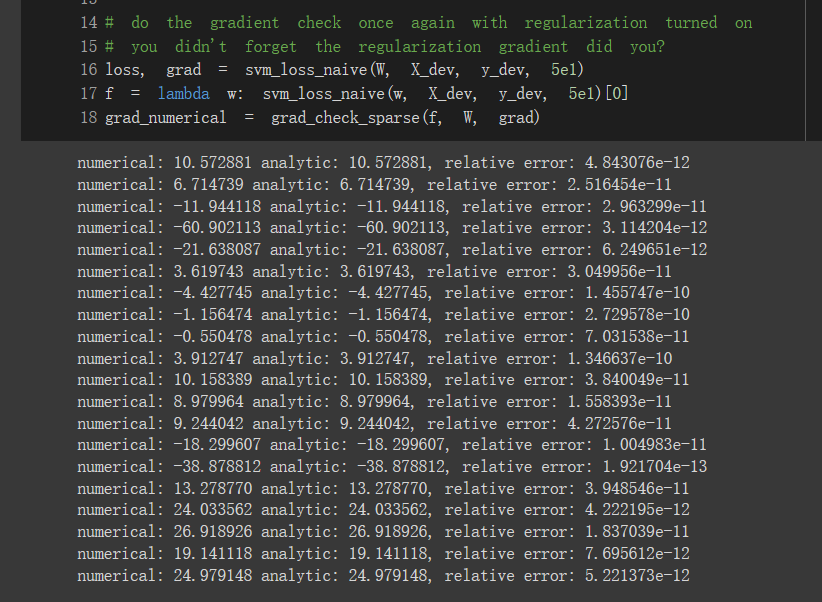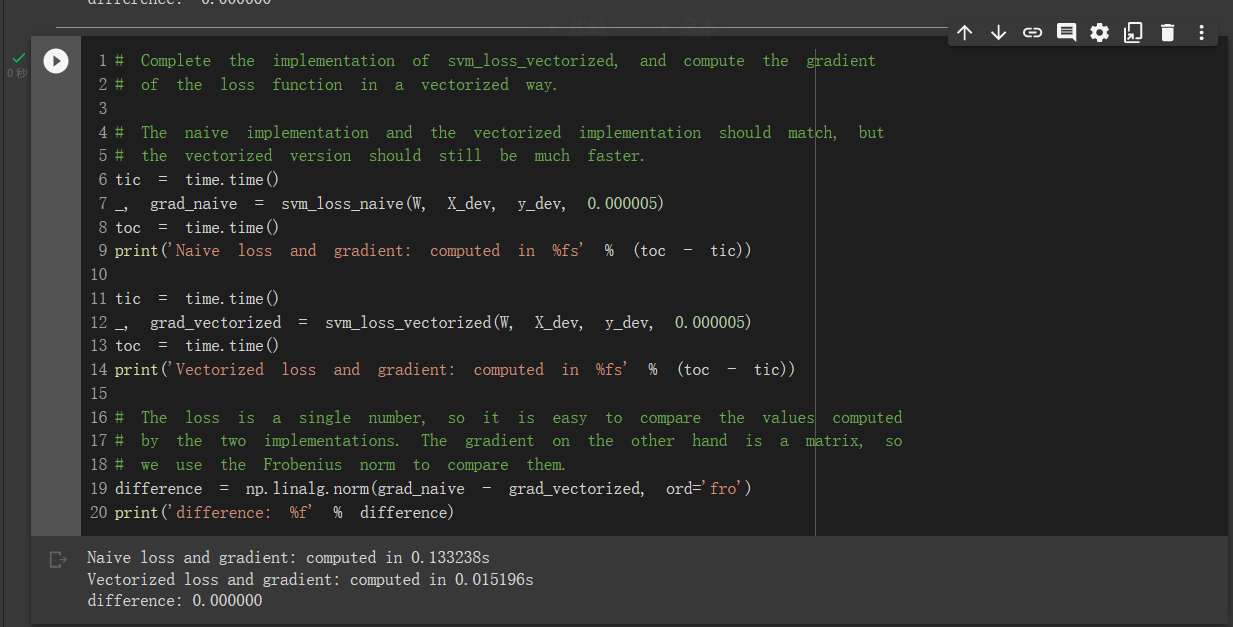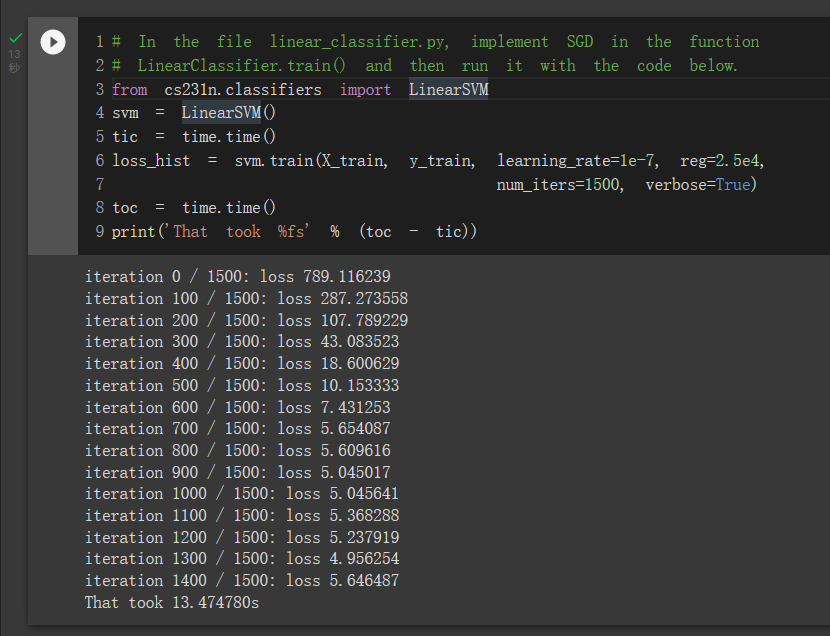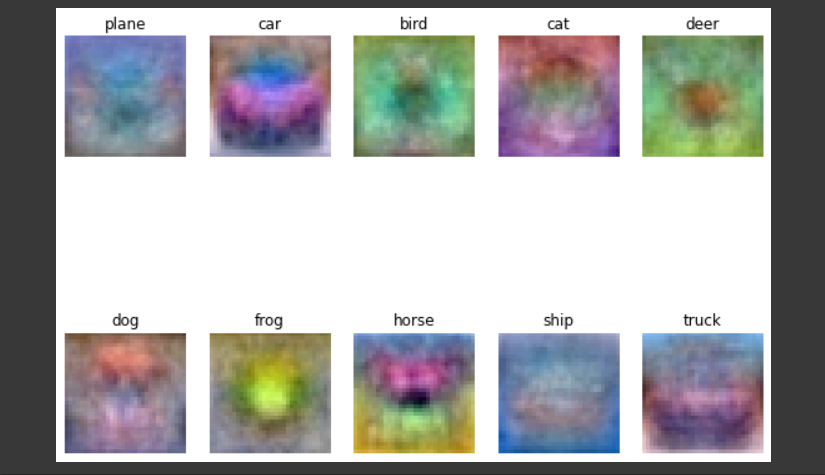Loss 函数
这次仍然是在 CIFAR-10 这一数据集上进行处理。
第一个任务是实现linear_svm.py 中 Loss 函数求导的部分,要求用朴素方法实现(带循环的)。完成后的svm_loss_naive如下:
def svm_loss_naive(W, X, y, reg):
"""
Structured SVM loss function, naive implementation (with loops).
Inputs have dimension D, there are C classes, and we operate on minibatches
of N examples.
Inputs:
- W: A numpy array of shape (D, C) containing weights.
- X: A numpy array of shape (N, D) containing a minibatch of data.
- y: A numpy array of shape (N,) containing training labels; y[i] = c means
that X[i] has label c, where 0 <= c < C.
- reg: (float) regularization strength
Returns a tuple of:
- loss as single float
- gradient with respect to weights W; an array of same shape as W
"""
dW = np.zeros(W.shape) # initialize the gradient as zero
# compute the loss and the gradient
num_classes = W.shape[1]
num_train = X.shape[0]
loss = 0.0
for i in range(num_train):
scores = X[i].dot(W)
correct_class_score = scores[y[i]]
for j in range(num_classes):
if j == y[i]:
continue
margin = scores[j] - correct_class_score + 1 # note delta = 1
if margin > 0:
loss += margin
dW[:,j] += X[i].T
dW[:,y[i]] -= X[i].T
# Right now the loss is a sum over all training examples, but we want it
# to be an average instead so we divide by num_train.
loss /= num_train
# Add regularization to the loss.
loss += reg * np.sum(W * W)
#############################################################################
# TODO: #
# Compute the gradient of the loss function and store it dW. #
# Rather that first computing the loss and then computing the derivative, #
# it may be simpler to compute the derivative at the same time that the #
# loss is being computed. As a result you may need to modify some of the #
# code above to compute the gradient. #
#############################################################################
# *****START OF YOUR CODE (DO NOT DELETE/MODIFY THIS LINE)*****
dW /= num_train
dW += reg * 2 * W
# *****END OF YOUR CODE (DO NOT DELETE/MODIFY THIS LINE)*****
return loss, dW
通过数值解对解析解进行检验,检验结果如下图所示:

误差均在可接受范围之内。
紧接着自然是向量化写法。完成后的svm_loss_vectorized如下:
def svm_loss_vectorized(W, X, y, reg):
"""
Structured SVM loss function, vectorized implementation.
Inputs and outputs are the same as svm_loss_naive.
"""
loss = 0.0
dW = np.zeros(W.shape) # initialize the gradient as zero
#############################################################################
# TODO: #
# Implement a vectorized version of the structured SVM loss, storing the #
# result in loss. #
#############################################################################
# *****START OF YOUR CODE (DO NOT DELETE/MODIFY THIS LINE)*****
num_classes = W.shape[1]
num_train = X.shape[0]
score = X.dot(W).T
choose = np.choose(y, score)
score = score-choose+1
score = np.maximum(score, 0)
margin = score.T
margin[np.arange(num_train),y] = 0
loss += np.sum(margin)
loss /= num_train
loss += reg * np.sum(W * W)
# *****END OF YOUR CODE (DO NOT DELETE/MODIFY THIS LINE)*****
#############################################################################
# TODO: #
# Implement a vectorized version of the gradient for the structured SVM #
# loss, storing the result in dW. #
# #
# Hint: Instead of computing the gradient from scratch, it may be easier #
# to reuse some of the intermediate values that you used to compute the #
# loss. #
#############################################################################
# *****START OF YOUR CODE (DO NOT DELETE/MODIFY THIS LINE)*****
k = np.zeros(margin.shape)
k[margin>0] = 1
row = np.sum(k, 1)
k[np.arange(num_train), y] -= row.T
dW = X.T.dot(k)
dW /= num_train
dW += reg * 2 * W
# *****END OF YOUR CODE (DO NOT DELETE/MODIFY THIS LINE)*****
return loss, dW
数值检验结果如下图所示:

梯度下降
完成了 Loss 函数之后,就要进入训练过程了。首先补全linear_classifier.py中的LinearClassifier.train()。这一函数的作用是,每一个 iteration 中选出 batch_size 个训练样本投入到 SVM 中,然后再计算一次 Loss 函数进行梯度下降,避免计算太频繁导致时间消耗过大。
完善后的LinearClassifier.train()如下:
def train(
self,
X,
y,
learning_rate=1e-3,
reg=1e-5,
num_iters=100,
batch_size=200,
verbose=False,
):
"""
Train this linear classifier using stochastic gradient descent.
Inputs:
- X: A numpy array of shape (N, D) containing training data; there are N
training samples each of dimension D.
- y: A numpy array of shape (N,) containing training labels; y[i] = c
means that X[i] has label 0 <= c < C for C classes.
- learning_rate: (float) learning rate for optimization.
- reg: (float) regularization strength.
- num_iters: (integer) number of steps to take when optimizing
- batch_size: (integer) number of training examples to use at each step.
- verbose: (boolean) If true, print progress during optimization.
Outputs:
A list containing the value of the loss function at each training iteration.
"""
num_train, dim = X.shape
num_classes = (
np.max(y) + 1
) # assume y takes values 0...K-1 where K is number of classes
if self.W is None:
# lazily initialize W
self.W = 0.001 * np.random.randn(dim, num_classes)
# Run stochastic gradient descent to optimize W
loss_history = []
for it in range(num_iters):
X_batch = None
y_batch = None
#########################################################################
# TODO: #
# Sample batch_size elements from the training data and their #
# corresponding labels to use in this round of gradient descent. #
# Store the data in X_batch and their corresponding labels in #
# y_batch; after sampling X_batch should have shape (batch_size, dim) #
# and y_batch should have shape (batch_size,) #
# #
# Hint: Use np.random.choice to generate indices. Sampling with #
# replacement is faster than sampling without replacement. #
#########################################################################
# *****START OF YOUR CODE (DO NOT DELETE/MODIFY THIS LINE)*****
choice = np.random.choice(a=num_train, size=batch_size, replace=False, p=None)
X_batch = X[choice]
y_batch = y[choice]
# *****END OF YOUR CODE (DO NOT DELETE/MODIFY THIS LINE)*****
# evaluate loss and gradient
loss, grad = self.loss(X_batch, y_batch, reg)
loss_history.append(loss)
# perform parameter update
#########################################################################
# TODO: #
# Update the weights using the gradient and the learning rate. #
#########################################################################
# *****START OF YOUR CODE (DO NOT DELETE/MODIFY THIS LINE)*****
self.W -= learning_rate * grad
# *****END OF YOUR CODE (DO NOT DELETE/MODIFY THIS LINE)*****
if verbose and it % 100 == 0:
print("iteration %d / %d: loss %f" % (it, num_iters, loss))
return loss_history
有两部分需要补全,第一个是随机选择数据,第二个是梯度下降,实现都比较简单。
之后的训练效果:


可以看出 Loss 下降还是非常明显的,代码实现没有问题。
继续完善LinearSVM.predict(),得到训练集与验证集上的准确率:

后面是调参环节,从不同的 learning rate 与 regularization strengths 中选出使验证集正确率最高的组合。对每一种组合都训一遍 SVM,然后计算一次正确率。不过在 learning rate 较大的两个情况训练时,发生了计算溢出的情况。题面中说这是正常现象,正确率接近39\%就算成功。我本地训练最好的结果是39.6\%,随后参考了一下别人的代码,写法上一模一样,但是人家就能达到40\%的正确率。。。只能说脸比较黑,初始位置选取不是太好。
补全后的调参代码如下:
# Use the validation set to tune hyperparameters (regularization strength and
# learning rate). You should experiment with different ranges for the learning
# rates and regularization strengths; if you are careful you should be able to
# get a classification accuracy of about 0.39 on the validation set.
# Note: you may see runtime/overflow warnings during hyper-parameter search.
# This may be caused by extreme values, and is not a bug.
# results is dictionary mapping tuples of the form
# (learning_rate, regularization_strength) to tuples of the form
# (training_accuracy, validation_accuracy). The accuracy is simply the fraction
# of data points that are correctly classified.
results = {}
best_val = -1 # The highest validation accuracy that we have seen so far.
best_svm = None # The LinearSVM object that achieved the highest validation rate.
################################################################################
# TODO: #
# Write code that chooses the best hyperparameters by tuning on the validation #
# set. For each combination of hyperparameters, train a linear SVM on the #
# training set, compute its accuracy on the training and validation sets, and #
# store these numbers in the results dictionary. In addition, store the best #
# validation accuracy in best_val and the LinearSVM object that achieves this #
# accuracy in best_svm. #
# #
# Hint: You should use a small value for num_iters as you develop your #
# validation code so that the SVMs don't take much time to train; once you are #
# confident that your validation code works, you should rerun the validation #
# code with a larger value for num_iters. #
################################################################################
# Provided as a reference. You may or may not want to change these hyperparameters
learning_rates = [1e-7, 5e-6]
regularization_strengths = [2.5e4, 5e4]
# *****START OF YOUR CODE (DO NOT DELETE/MODIFY THIS LINE)*****
for lr in learning_rates:
for reg in regularization_strengths:
svm = LinearSVM()
svm.train(X_train, y_train, learning_rate=lr, reg=reg, num_iters=1500, verbose=True)
y_train_pred = np.mean(y_train == svm.predict(X_train))
y_val_pred = np.mean(y_val == svm.predict(X_val))
results[(lr, reg)] = (y_train_pred, y_val_pred)
if y_val_pred > best_val:
best_val = y_val_pred
best_svm = svm
# *****END OF YOUR CODE (DO NOT DELETE/MODIFY THIS LINE)*****
# Print out results.
for lr, reg in sorted(results):
train_accuracy, val_accuracy = results[(lr, reg)]
print('lr %e reg %e train accuracy: %f val accuracy: %f' % (
lr, reg, train_accuracy, val_accuracy))
print('best validation accuracy achieved during cross-validation: %f' % best_val)
最终在测试集上取得了37.3\%的效果,将权重可视化之后,发现学习到的分类器如下图所示:

效果挺有趣,能看出学了一个轮廓以及颜色出来。
Inline Question
Q1

梯度不完全匹配的原因可能有浮点误差,以及数值解与解析解之间的精度误差,解析解本身也可能会和实际梯度有所偏差。这是因为所要求导的函数在原点处是不可微的,所以如果求导的位置与原点过于接近的话,解析解就可能出现误差。
这些情况对实际求解并没有太大影响。想要追求更高的验证精度可以减小\Delta x。
Q2

第i层权重像第i个分类所对应的物体的图片。这是因为 SVM 会通过二者的相似程度来进行打分,所以为了使某一种类的分数比其他种类高,SVM 就会尽可能记住这个种类比较普遍的特点。所以将权重可视化之后会像对应分类的物体。
感想
这一次对 numpy 的熟练度要求更高了,且更具有技巧性。向量法求 Loss 函数那里卡了很久,一直没有想好怎么把朴素解法的 if 给去掉。参考了别人的答案后才发现可以借助另一个矩阵进行求解。后面的实现相对来说比较简单,一路做下去没有太大压力。
目前的内容还没有涉及较为复杂的数学推导,理解起来也很轻松(可能和我之前有一定基础有关)。马上就要到神经网络部分了,希望在完成后面的习题的时候可以多多尝试一些在这块学到的 numpy 技巧,刷网课的速度也要加快了,时间不多了。
本文地址: 深度学习课程 CS231n Assignment1 SVM部分

